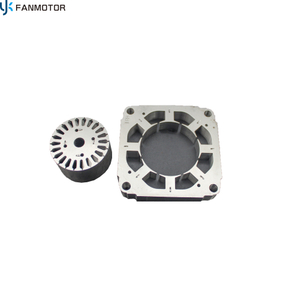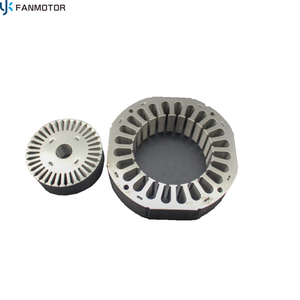AC (Alternating Current) motors are widely used in various applications due to their reliability, efficiency, and ease of maintenance. The efficiency of an AC motor is a critical factor that determines its performance, energy consumption, and overall operating cost. In this article, we will explore the relationship between stator and rotor design and AC motor efficiency, focusing on the key design aspects that influence motor performance.
AC motor efficiency is defined as the ratio of mechanical output power to the electrical input power, expressed as a percentage. A higher efficiency indicates that the motor converts a larger portion of the electrical energy into useful mechanical work, while a lower efficiency means that more energy is wasted as heat or other losses. Motor efficiency is influenced by various factors, including design, materials, operating conditions, and load characteristics.
Stator Design and Its Impact on Motor Efficiency
Stator Core Material and Construction
The stator core is a crucial component of an AC motor, as it forms the magnetic circuit and provides the necessary magnetic field for motor operation. The choice of stator core material and construction significantly impacts motor efficiency. High-quality electrical steel with low hysteresis and eddy current losses is typically used for stator cores. These materials have high magnetic permeability and low resistivity, reducing core losses.
The construction of the stator core involves stacking thin laminations of electrical steel, insulated from each other to minimize eddy current losses. The thickness of the laminations is a critical design parameter, with thinner laminations resulting in lower eddy current losses. However, thinner laminations may increase manufacturing costs and reduce mechanical strength. The optimal lamination thickness balances cost, performance, and mechanical requirements.
Stator Winding Configuration and Losses
The stator winding configuration plays a significant role in determining motor efficiency. Stator windings are typically made of copper or aluminum conductors, which have low resistivity and high conductivity. The winding configuration, including the number of turns, phase arrangement, and slot fill factor, affects the winding losses and the motor’s magnetic performance.
Winding losses, also known as copper losses, occur due to the resistance of the winding conductors. These losses are proportional to the square of the current flowing through the windings and can be minimized by using larger conductors, reducing the winding resistance, and optimizing the winding configuration. Additionally, using high-conductivity materials, such as oxygen-free copper or silver-plated conductors, can further reduce winding losses and improve motor efficiency.
Air Gap Dimensions and Magnetic Flux Distribution
The air gap between the stator and rotor is a critical design parameter that influences motor efficiency. The air gap dimensions, including the radial and axial clearance, affect the magnetic reluctance and the distribution of the magnetic flux. A smaller air gap results in lower magnetic reluctance and higher magnetic coupling between the stator and rotor, improving motor efficiency.
However, reducing the air gap dimensions also increases the risk of mechanical contact between the stator and rotor, leading to increased friction losses and potential damage. Therefore, it is essential to optimize the air gap dimensions to achieve a balance between mechanical stability and magnetic performance. Additionally, the uniformity of the air gap is crucial for minimizing cogging torque and torque ripple, which can affect motor efficiency and performance.
Rotor Design and Its Influence on Motor Efficiency
Rotor Core Material and Construction
The rotor core is another critical component that significantly influences AC motor efficiency. Like the stator core, the rotor core is typically made of laminated electrical steel to reduce core losses. The choice of rotor core material, lamination thickness, and stacking method are essential design considerations that affect rotor performance and motor efficiency.
The rotor core construction involves stacking thin laminations of electrical steel, insulated from each other to minimize eddy current losses. The lamination thickness and the type of rotor construction, such as squirrel cage or wound rotor, influence the rotor’s magnetic performance and loss characteristics. Squirrel cage rotors, commonly used in induction motors, consist of conductive bars shorted at both ends by end rings, forming a closed-loop circuit. This construction provides low rotor resistance and high efficiency, making it suitable for most industrial applications.
End Ring Design and Its Role in Loss Reduction
The end rings are integral to the rotor’s mechanical and magnetic performance. They connect the rotor bars, forming a closed-loop circuit that allows the flow of induced currents. The design of the end rings, including their material, geometry, and dimensions, plays a crucial role in determining rotor resistance, leakage reactance, and motor efficiency.
Using high-conductivity materials, such as copper or aluminum, for the end rings can reduce resistive losses and improve motor efficiency. Additionally, optimizing the geometry and dimensions of the end rings can minimize leakage reactance and improve the rotor’s magnetic coupling with the stator. This, in turn, enhances the motor’s torque-producing capability and efficiency.
Slip and Its Effect on Efficiency
Slip is the difference between the synchronous speed of the stator magnetic field and the actual speed of the rotor. It is a critical parameter that influences AC motor efficiency and performance. Slip is necessary for torque production in induction motors, as it creates the relative motion between the stator magnetic field and the rotor currents.
Higher slip values result in increased rotor current and torque production, but they also lead to higher rotor losses and reduced motor efficiency. Conversely, lower slip values indicate higher rotor speeds and reduced torque production, but they also result in lower rotor losses and improved motor efficiency. Therefore, it is essential to optimize slip for specific applications and operating conditions to achieve the desired balance between motor performance and efficiency.
Balancing Performance and Efficiency in AC Motor Design
In AC motor design, it is crucial to strike a balance between performance and efficiency. While optimizing individual design parameters can lead to improved efficiency, it may also result in trade-offs in other performance aspects, such as torque, speed, and reliability.
For example, reducing the air gap dimensions can improve motor efficiency by enhancing magnetic coupling between the stator and rotor. However, it may also increase the risk of mechanical contact and reduce motor reliability. Similarly, using high-conductivity materials for stator and rotor windings can reduce resistive losses and improve efficiency but may increase manufacturing costs.
Therefore, it is essential to consider the specific application requirements, operating conditions, and cost constraints when designing AC motors. By carefully selecting and optimizing design parameters, it is possible to achieve a motor that meets the desired performance and efficiency criteria while remaining cost-effective and reliable.
Conclusion
The relationship between stator and rotor design and AC motor efficiency is complex and multifaceted. Various design parameters, such as core materials, winding configurations, air gap dimensions, and slip, significantly impact motor efficiency and performance.
By understanding these relationships and carefully optimizing design parameters, it is possible to achieve AC motors with high efficiency, reliability, and performance. These motors can meet the diverse needs of various applications, from industrial machinery to consumer appliances, while minimizing energy consumption and operating costs.
In conclusion, the design and selection of stator and rotor components are critical to AC motor efficiency. By considering these factors, engineers and designers can develop motors that provide optimal performance and efficiency for specific applications, contributing to more sustainable and energy-efficient technologies.














